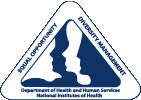|
Home
>Diversity Management >NIH Diversity Council
NIH Diversity Council
Welcome!Thank you for visiting our page and the website for NIH's Office of Equal Employment Opportunity and Diversity Management. NIH's Diversity Council is chartered to advise NIH Director Dr. Elias Zerhouni and his designees on policies and programs to promote and manage diversity across the 27 Institutes and Centers that comprise the National Institutes of Health. NIH is diverse in its comprehensive approach to resolving public health problems and in the many locales where we work to improve the public's health-from Baltimore, to suburban Maryland, to North Carolina! We're a diverse people, too. We're security guards, grants clerks, lab techs, nurses, physicians, researchers, administrators, among others! Your Diversity Council has members who represent many cultures, groups, and occupations. Please learn more about us and our members by checking our membership roster. We meet on the third Wednesday of the month from 2:30 to 4:00 p.m. You're always welcome. Check our schedule-our next meeting could be right near you! Since our establishment, this Council has produced meetings and materials to fulfill our chartered goals. For example, in 2006, members Drs. David Robinson (NIDCD) and Marisela Morales (NIDA) completed work to help NIH recruit and retain minority intramural researchers. Matthew Murguia (NIAID) integrated our Diversity Councilors' and stakeholders' input to create a communication plan to help all NIH-ers to feel comfortable and supported as we all work to acquire new knowledge to help prevent, detect, diagnose, and treat disease and disability, from the rarest genetic disorder to the common cold. In 2007, you can join us as we implement components to our communication plan, strengthen our partnerships among all NIH affinity groups and related councils, and assess our overall progress. Three of my grandparents emigrated to this country; one of them raised me. Before I came to NIH, I conducted behavioral health research with many underserved and minority populations. My experience with all these people-relatives and research participants alike-informs my commitment and practice to diversity and to this Council. Every Diversity Councilor brings her/his own personal and professional motivations to serve at meetings and on our projects. Thank you for visiting us. I hope you'll visit one of our meetings to share and practice your own commitment to diversity with us. Best regards,
William N. Elwood, Ph.D. |
Office of Equal Opportunity
& Diversity Management
U.S. Department of Health & Human Services
National Institutes of Health






